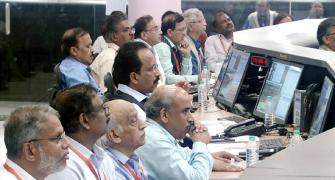In a boost to the space programme, the government on Wednesday approved the Chandrayaan-4 mission to bring back moon rocks to earth, to send a spacecraft to orbit planet Venus and to expand the Gaganyaan project to build an Indian space station.

The Union cabinet, at a meeting chaired by Prime Minister Narendra Modi, also approved a proposal of the Department of Space to build a Next Generation Launch Vehicle capable of placing heavier payload in orbits, which could also be key to achieving the targets of setting up a space station and landing an Indian astronaut on the moon.
'Great news for the space sector! The Union Cabinet has approved the first step towards the Bharatiya Antariksh Station (BAS), expanding the Gaganyaan programme,' Modi said in a post on X.
'This landmark decision brings us closer to a self-sustained space station by 2035 and a crewed lunar mission by 2040,' the prime minister said.
Briefing reporters about the cabinet decisions, Information and Broadcasting Minister Ashwini Vaishnaw said that the government has allocated Rs 2,104 crore for the Chandrayaan-4 mission.
"A natural successor to Chandrayaan-3 is the demonstration of the ability to collect lunar samples and return them safely back to Earth," ISRO Chairman S Somanath said.
The Chandrayaan-4 will involve multiple launches, and the premier space agency is set to perform a space docking experiment later this year to develop its capabilities for the challenging endeavour.
The Cabinet approved Rs 1,236 crore for the Venus Orbiter Mission (VOM), which is expected to be launched sometime in March 2028.
The VOM will be India's second interplanetary mission after the Mars Orbiter Mission that was launched on November 5, 2013, and entered the Martian orbit on September 24, 2014.
The Venus mission will study the surface topography of the planet, Venusian dust and clouds, lightning, volcanic activity, atmosphere, ionosphere, solar forcing and the Sun-Venus interaction.
"The Venus mission will also study the underlying causes of the transformation of Venus, which is believed to be once habitable and quite similar to Earth," an official said.
The cabinet also approved the development of the Next Generation Launch Vehicle (NGLV) which will be used for operating missions to the BAS and sending an Indian astronaut on the moon.
The current fleet of launch vehicles in ISRO's stable -- SSLV, PSLV, GSLV and LVM3 -- are capable of carrying payloads of up to 10 tonnes to the Low Earth Orbit and four-tonne payload to the Geo-Synchronous Transfer Orbit.
"India's space ambitions take yet another important leap with the approval of the Next Generation Launch Vehicle (NGLV)! This will bring us closer to establishing the Bharatiya Antariksh Station and achieving a crewed Moon landing by 2040," Modi said.
The cabinet also approved a proposal to expand the scope of the Gaganyaan programme to build the first unit of the Bharatiya Anatriksh Station.
The approval includes missions to demonstrate and validate various technologies for building and operating BAS.
"Now the human spaceflight program of technology development and demonstration is through eight missions to be completed by December 2028 by launching the first unit of BAS-1," an official statement said.
The cabinet also approved an additional funding of Rs 11,170 crore to the Gaganyaan Programme, which already has a sanctioned budget of Rs 9,023 crore.









